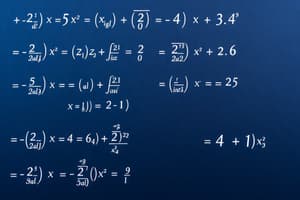Podcast
Questions and Answers
Match the given properties of quadratic equations with their descriptions:
Match the given properties of quadratic equations with their descriptions:
Exact number of solutions = Two solutions Graph of a quadratic equation = A parabola that opens upward or downward Degree of the polynomial equation = Two Type of roots = Real or complex
Match the methods for solving quadratic equations with their descriptions:
Match the methods for solving quadratic equations with their descriptions:
Factoring = If the equation can be written in the form (x - r)(x - s) = 0 Quadratic Formula = If the equation cannot be factored Graphing = Finding the x-intercepts Long Division = Not applicable
Match the discriminant values with the number of solutions:
Match the discriminant values with the number of solutions:
Positive = Two distinct real solutions Zero = One repeated real solution Negative = Two complex solutions Any = None of the above
Match the applications of quadratic equations with their descriptions:
Match the applications of quadratic equations with their descriptions:
Match the parts of a quadratic equation with their descriptions:
Match the parts of a quadratic equation with their descriptions:
Match the quadratic equation forms with their descriptions:
Match the quadratic equation forms with their descriptions:
Match the characteristics of quadratic equation graphs with their descriptions:
Match the characteristics of quadratic equation graphs with their descriptions:
Match the quadratic equation solutions with their descriptions:
Match the quadratic equation solutions with their descriptions:
Match the quadratic equation terms with their coefficients:
Match the quadratic equation terms with their coefficients:
Match the quadratic equation applications with their fields:
Match the quadratic equation applications with their fields:
Flashcards are hidden until you start studying
Study Notes
Quadratic Equations
Definition
- A quadratic equation is a polynomial equation of degree two, which means the highest power of the variable (usually x) is two.
- The general form of a quadratic equation is: ax^2 + bx + c = 0, where a, b, and c are constants.
Properties
- A quadratic equation has exactly two solutions, which may be real or complex.
- The graph of a quadratic equation is a parabola that opens upward or downward.
Methods for Solving Quadratic Equations
- Factoring: If the equation can be written in the form (x - r)(x - s) = 0, then the solutions are x = r and x = s.
- Quadratic Formula: If the equation cannot be factored, the quadratic formula can be used to find the solutions. The formula is: x = (-b ± √(b^2 - 4ac)) / 2a.
- Graphing: The solutions can be found by graphing the related function and finding the x-intercepts.
Solving Quadratic Equations with Real Coefficients
- If the discriminant (b^2 - 4ac) is:
- Positive, the equation has two distinct real solutions.
- Zero, the equation has one repeated real solution.
- Negative, the equation has two complex solutions.
Applications of Quadratic Equations
- Projectile motion: Quadratic equations can be used to model the trajectory of an object under the influence of gravity.
- Optimization problems: Quadratic equations can be used to find the maximum or minimum value of a function.
- Physics and engineering: Quadratic equations are used to describe the motion of objects, including the acceleration and deceleration of particles and the stress and strain of materials.
Quadratic Equations
Definition
- A quadratic equation is a polynomial equation of degree two, meaning the highest power of the variable (usually x) is two.
- The general form of a quadratic equation is ax^2 + bx + c = 0, where a, b, and c are constants.
Properties
- Quadratic equations have exactly two solutions, which may be real or complex.
- The graph of a quadratic equation is a parabola that opens upward or downward.
Methods for Solving Quadratic Equations
Factoring
- If the equation can be written in the form (x - r)(x - s) = 0, then the solutions are x = r and x = s.
Quadratic Formula
- The quadratic formula is x = (-b ± √(b^2 - 4ac)) / 2a.
- It is used to find the solutions when the equation cannot be factored.
Graphing
- The solutions can be found by graphing the related function and finding the x-intercepts.
Solving Quadratic Equations with Real Coefficients
- The discriminant (b^2 - 4ac) determines the type of solutions:
- Positive: two distinct real solutions.
- Zero: one repeated real solution.
- Negative: two complex solutions.
Applications of Quadratic Equations
Projectile Motion
- Quadratic equations model the trajectory of an object under the influence of gravity.
Optimization Problems
- Quadratic equations are used to find the maximum or minimum value of a function.
Physics and Engineering
- Quadratic equations describe the motion of objects, including acceleration and deceleration of particles.
- They describe the stress and strain of materials.
Studying That Suits You
Use AI to generate personalized quizzes and flashcards to suit your learning preferences.




